To stop state-level outbreaks, Nigeria is integrating 7-1-7 in its national emergency management system
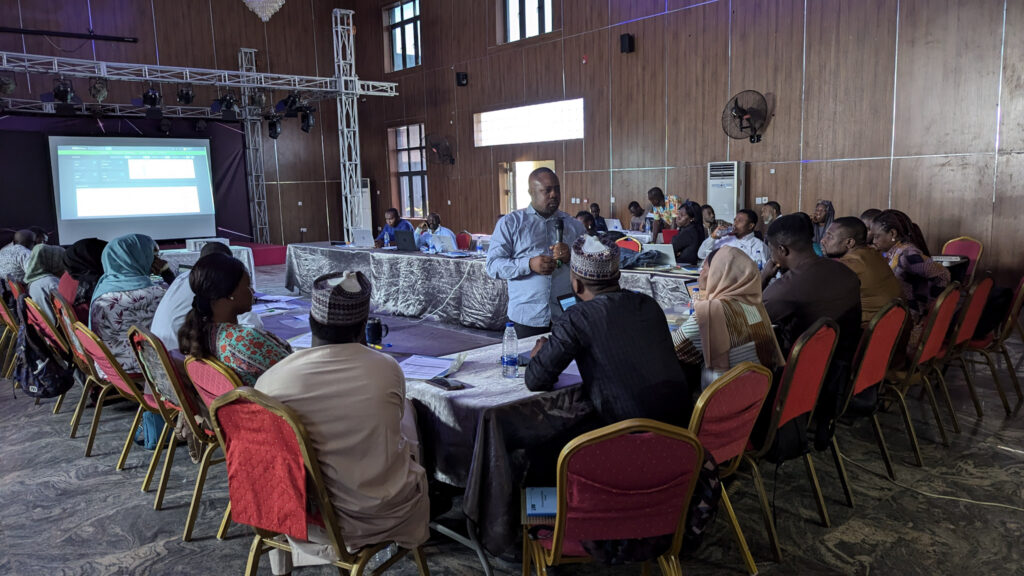
Nigeria is integrating the 7-1-7 target into its SITAware system to detect and respond to outbreaks faster—empowering frontline workers and setting a regional standard for epidemic preparedness.
How event-based surveillance is saving lives across Africa
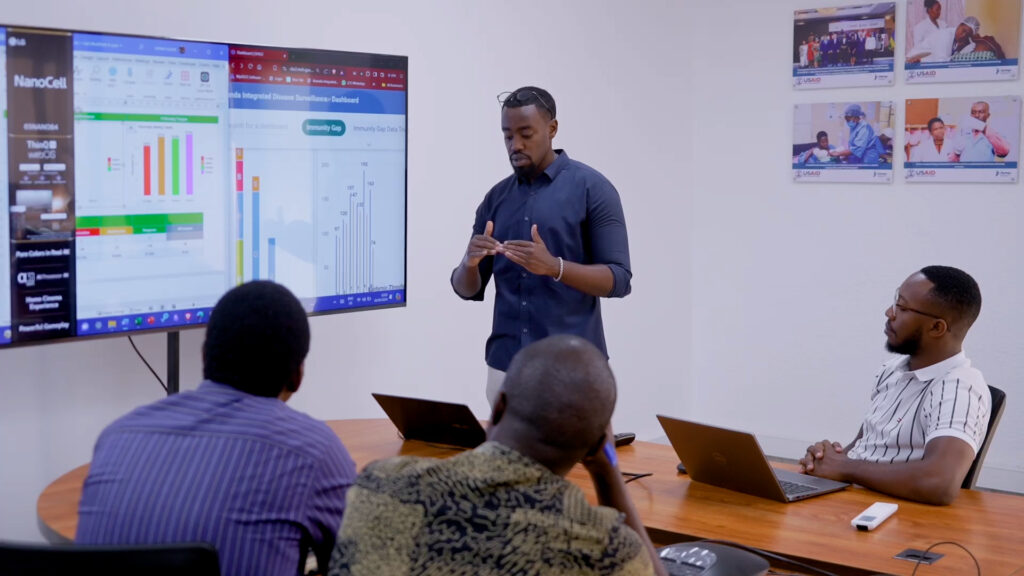
We partnered with National Public Health Institutes in five African countries to detect outbreaks faster using early warning signals.
Unleashing the full potential of 7-1-7
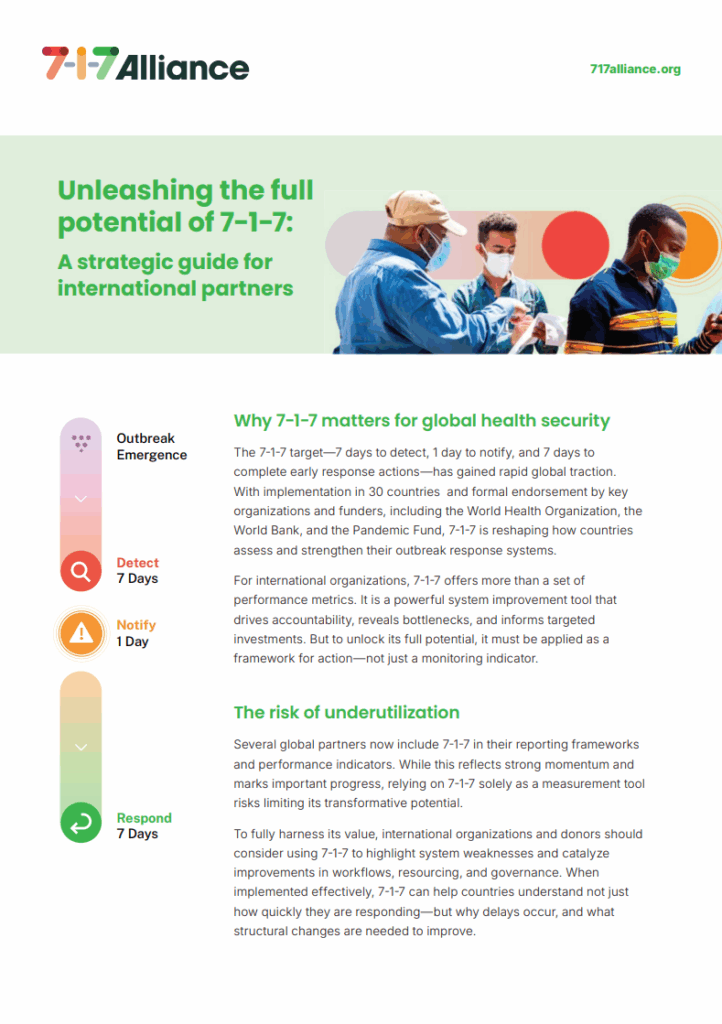
A strategic guide for international partners on the powerful system improvement tool that drives accountability, reveals bottlenecks, and informs targeted investments.
From 18 countries to yours: Actionable 7‑1‑7 bottleneck insights
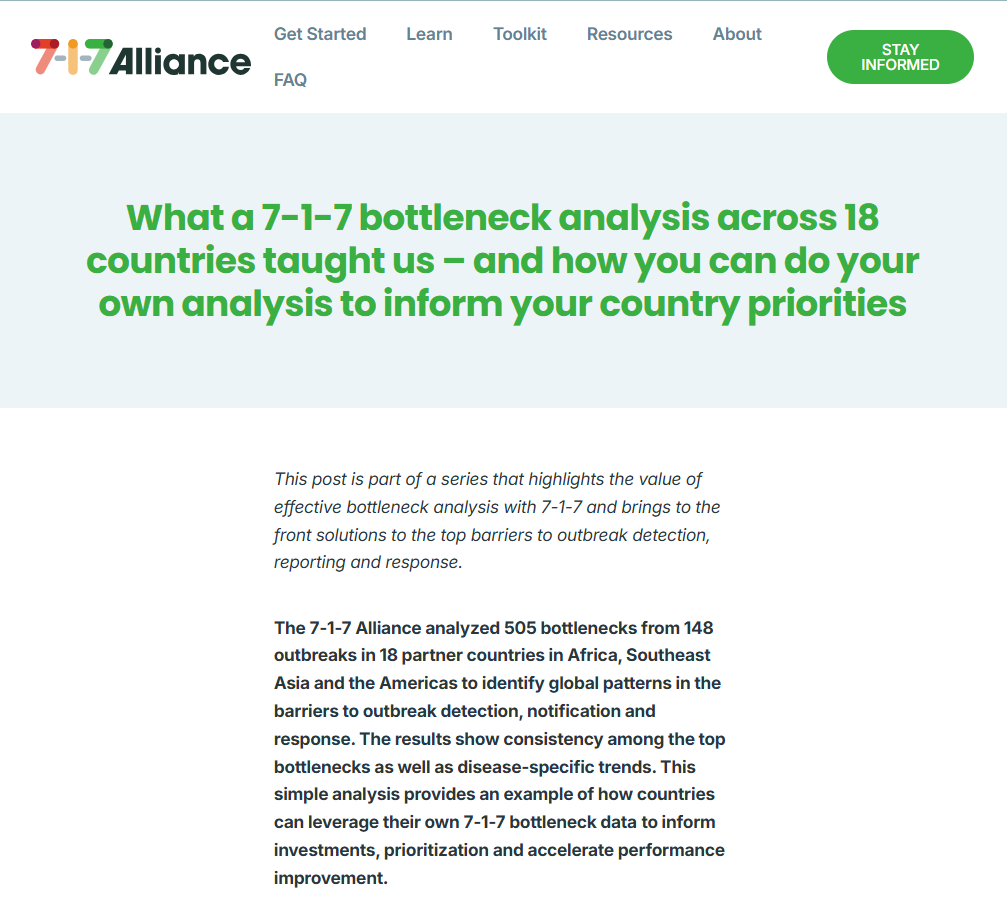
The 7-1-7 Alliance to identifies global patterns in the barriers to outbreak detection, notification and response and provides an example of how countries can leverage their own 7-1-7 bottleneck data to inform investments, prioritization and accelerate performance improvement.
Actionable 7‑1‑7 bottleneck insights: Resources for rapid outbreak investigation
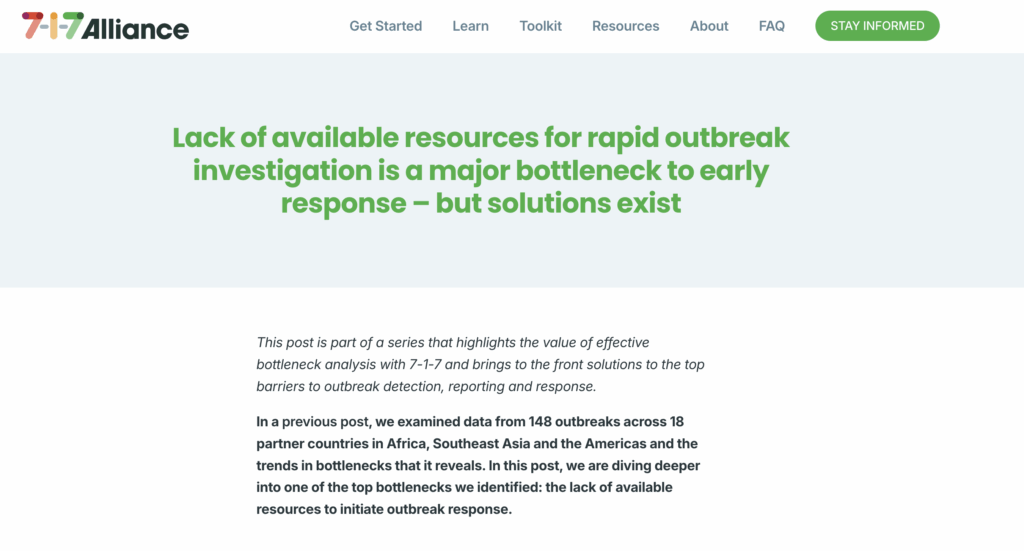
This resource from the 7-1-7 Alliance is part of a series that highlights the value of effective bottleneck analysis with 7-1-7 and brings to the front solutions to the top barriers to outbreak detection, reporting and response.
With significant progress in Recife, Brazil expands 7-1-7

In early 2023, health officials in Recife, Brazil started applying the 7-1-7 target for timely detection and control of infectious disease outbreaks as part of their plan to track and contain outbreaks during Carnival. New data shows over 30% improvement in reaching the target over two years.
Widespread adoption of 7-1-7 in Uganda leads to rapid improvement and increased community protection
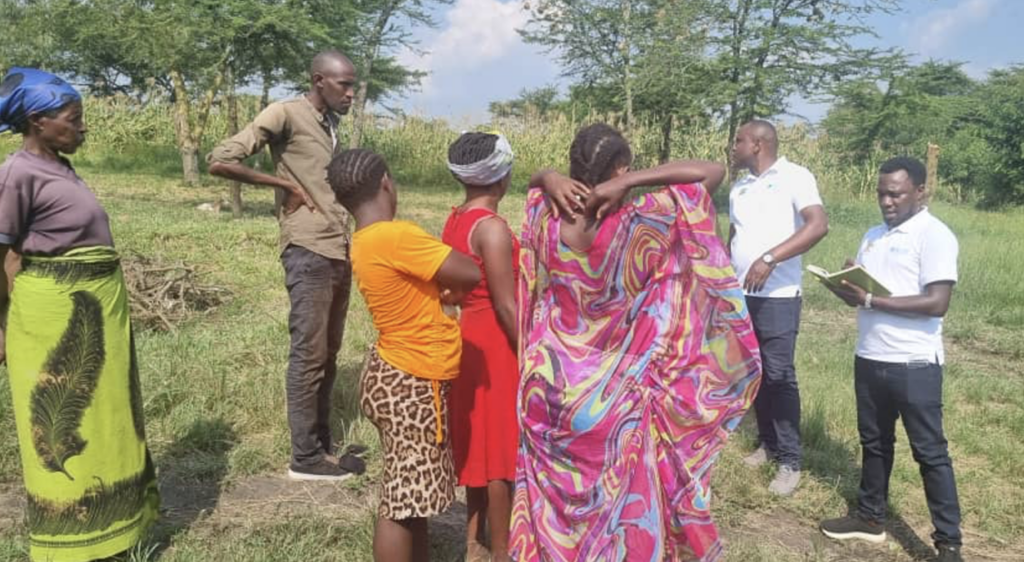
Deploying the 7-1-7 target during measles outbreaks in Uganda’s Kasese and Kiboga districts in early 2024 helped mobilize the political will and the resources necessary to respond to the outbreaks. It also helped the districts react more quickly when an even more deadly virus, the Crimean-Congo hemorrhagic fever, was detected months later.
Using timeliness metrics for household contact tracing and TB preventive therapy
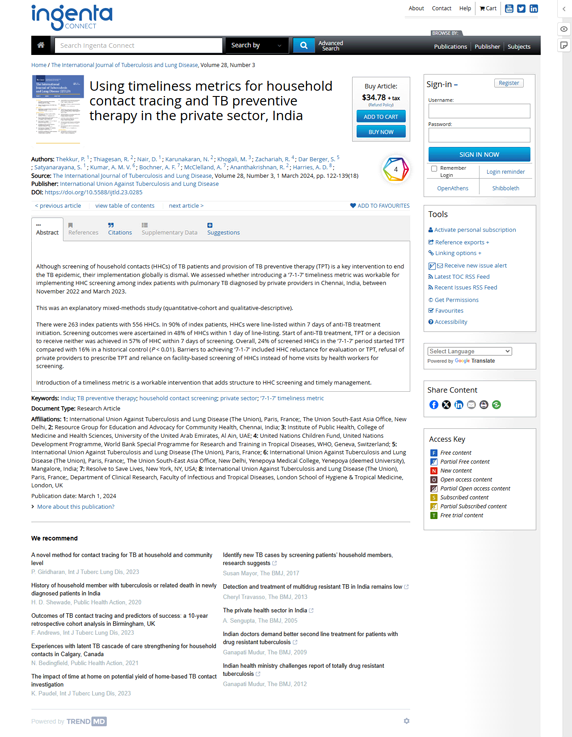
Can 7-1-7 help household contacts of tuberculosis patients get started on preventive therapy? In the International Journal of Tuberculosis and Lung Disease, our colleagues at International Union Against Tuberculosis and Lung Disease used a mixed-methods approach to assess the feasibility of the timeliness metric in the private sector in Chennai, India. Among 263 index patients, […]
7-1-7 helps Kenya quickly contain Rift Valley Fever outbreak

Seasonal heavy rains can spark mosquito-borne infections in livestock and spill over into humans. By applying the 7-1-7 target during a recent outbreak of Rift Valley Fever, Kenya was able to identify barriers to an effective response and quickly get resources to the affected region.
7-1-7: rapid improvement for early disease detection and response
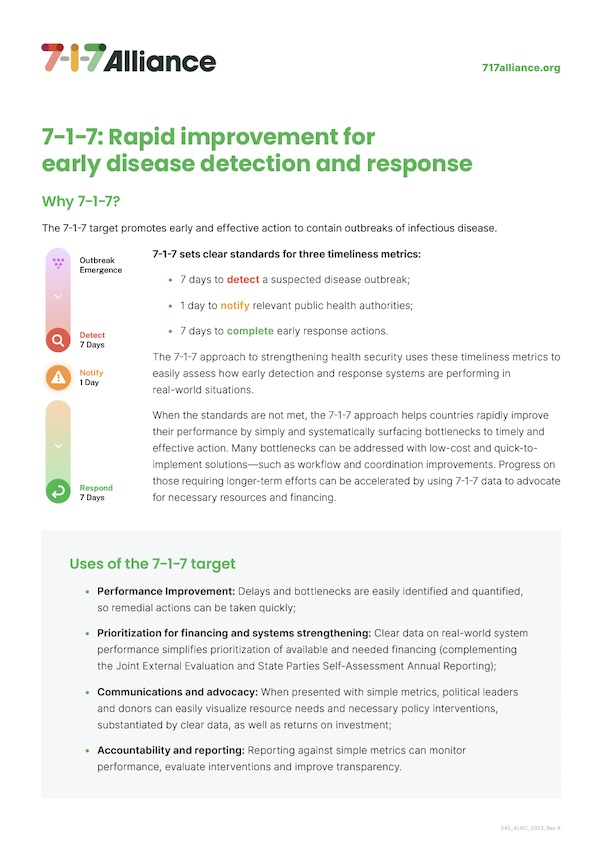
Introductory brief on the 7-1-7 target, its uses, and how it complements existing tools and assessments.
7-1-7 for Accountability, Monitoring and Evaluation
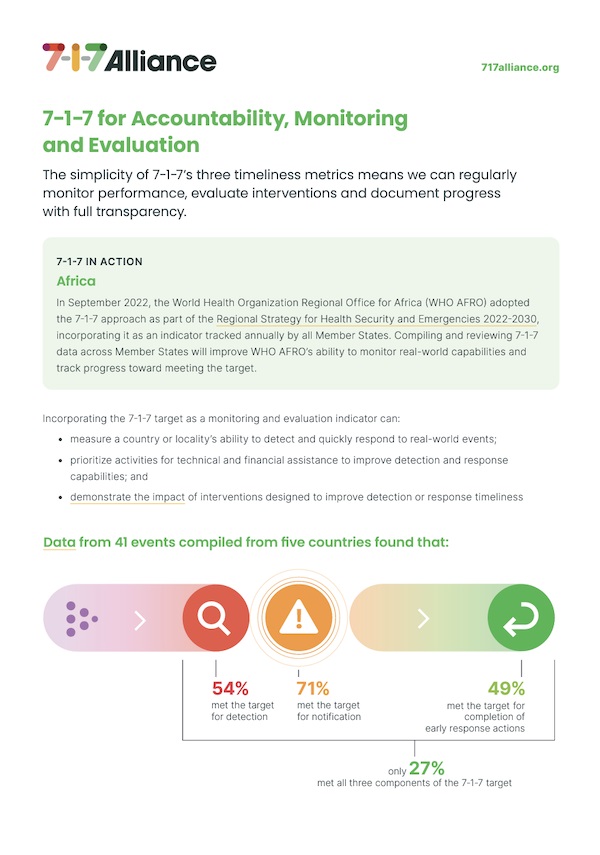
The simplicity of 7-1-7’s timeliness metrics helps monitor performance, evaluate interventions and document progress with full transparency.
Advocacy as easy as 7-1-7
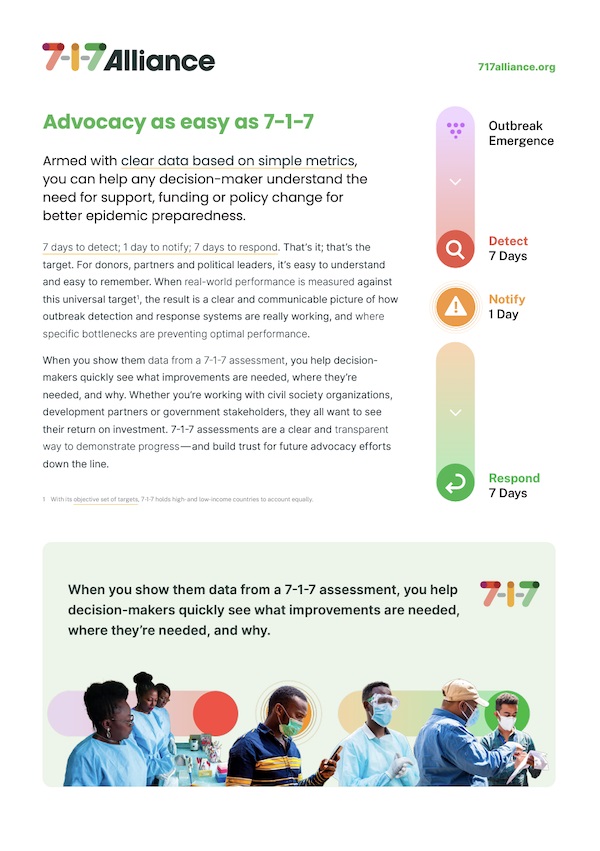
Clear data based on simple metrics can help any decision-maker understand the need for support, funding or policy change for better epidemic preparedness.
Continuous improvement with 7-1-7

By incorporating 7-1-7 into existing workflows, we can make every outbreak an opportunity to improve how we detect and respond to infectious disease threats.
Why 7-1-7? The evidence behind the global target for containing epidemic threat

Overview of the 7-1-7 evidence base.
Overview of the 7-1-7 Alliance
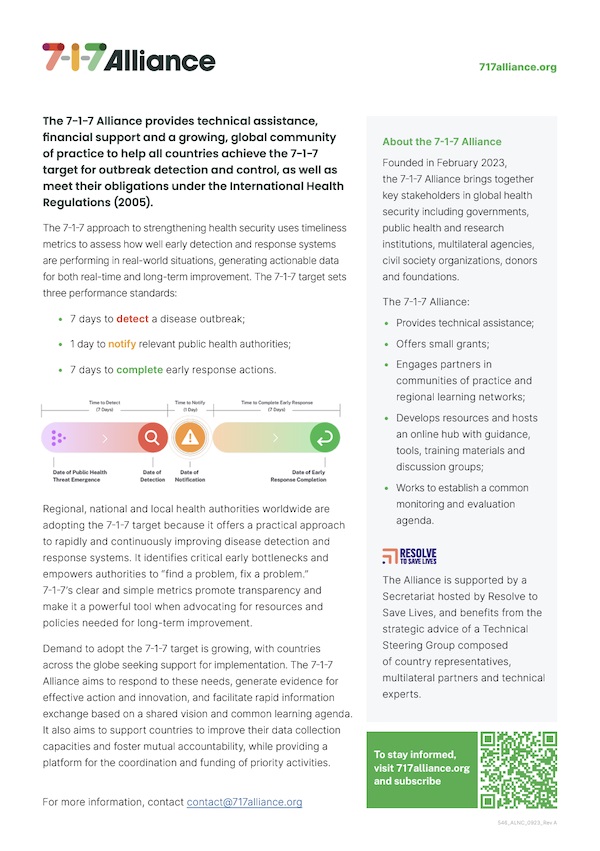
Introductory brief on the7-1-7 Alliance, the 7-1-7 target, and the Alliance missions.
Digital toolkit
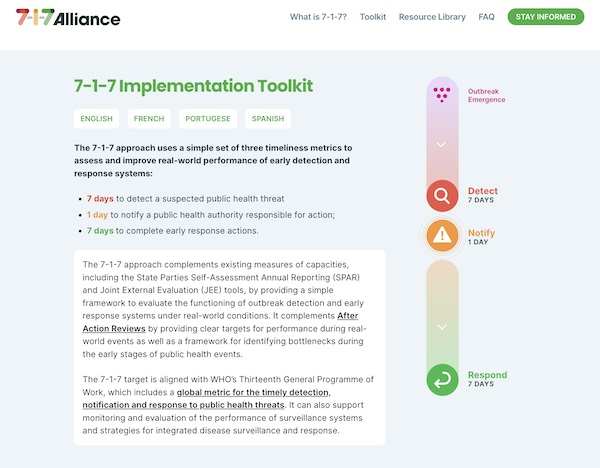
Step-by-step guidance and tools to start putting 7-1-7 to work, in one place.
Operational Planning and Priority-Setting Using 7-1-7 to Strengthen Uganda’s Health Security

A case study on how the 7-1-7 approach bolstered Uganda’s National Action Plan for Health Security (NAPHS).
7-1-7 Pilot Project
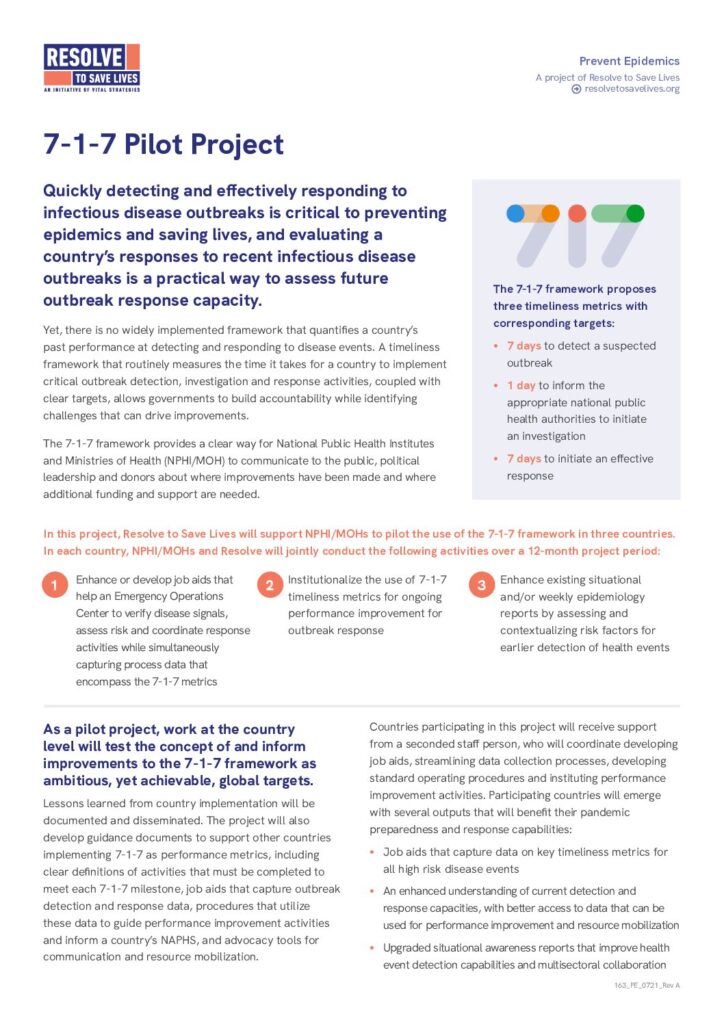
The 7-1-7 framework helps countries strengthen their outbreak detection and response by setting clear targets: 7 days to detect a suspected outbreak, 1 day to inform public health authorities, and 7 days to initiate a response. This pilot project tested the framework in three countries to improve pandemic preparedness and guide performance improvements.
Growing adoption of 7-1-7 on display at the 2024 Global Health Security Conference

On June 20, 2024, the 7-1-7 Alliance hosted a packed networking breakfast at the Global Health Security Conference in Sydney for partners engaged in the adoption and use of the 7-1-7 target for the timely detection, notification and response of infectious disease outbreaks.
New report offers lessons on stopping disease outbreaks, amid global spread of H5N1
Resolve to Save Lives report shows how public health specialists around the world controlled bird flu and other outbreaks last year June 18, 2024 (New York, NY) – With the highly contagious H5N1 avian influenza (bird flu) spreading worldwide, Finland provides a lesson in how to bring an outbreak under control quickly. After a deadly outbreak […]
7-1-7 saves lives in South Sudan
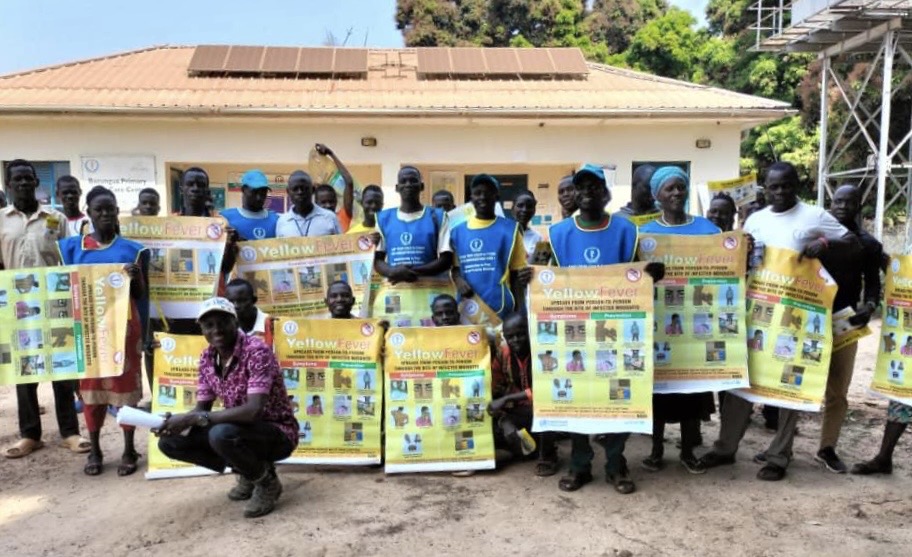
Yellow fever is endemic throughout sub-Saharan Africa. But the 7-1-7 target is helping contain outbreaks quickly.
U.S. public health leaders discuss nationwide adoption of 7‑1‑7
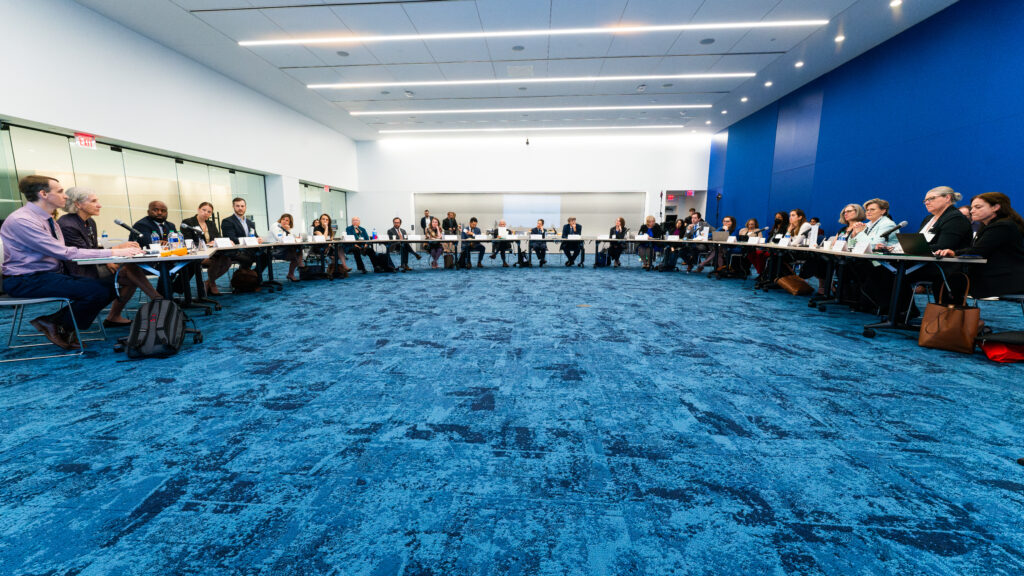
Participants at a Georgetown Center for Global Health Science and Security leadership roundtable discussed a path to a national adoption of the 7-1-7 target in the U.S.
New U.S. Global Health Security Strategy includes 7‑1‑7

The 7-1-7 target will be used to help U.S. partners assess and improve the real-world performance of their detection, notification and early response systems.
Timeliness metrics for screening and preventing TB in household contacts of pulmonary TB patients in Kenya
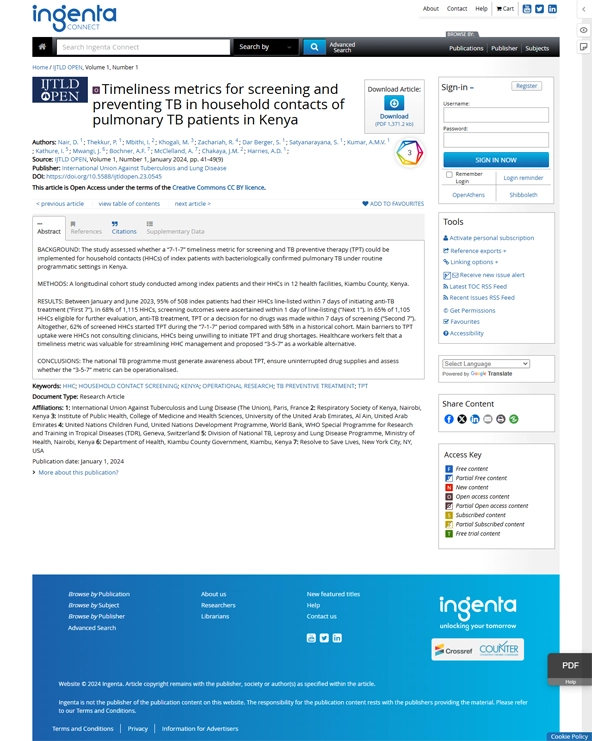
In a study published in the International Journal of Tuberculosis and Lung Disease, our colleagues at the International Union Against Tuberculosis and Lung Disease and the Respiratory Society of Kenya evaluated the feasibility of implementing a “7-1-7” timeliness metric for screening and initiating TB preventive therapy (TPT) among household contacts (HHCs) of index patients with […]
Celebrating the progress and partnerships that defined 2023
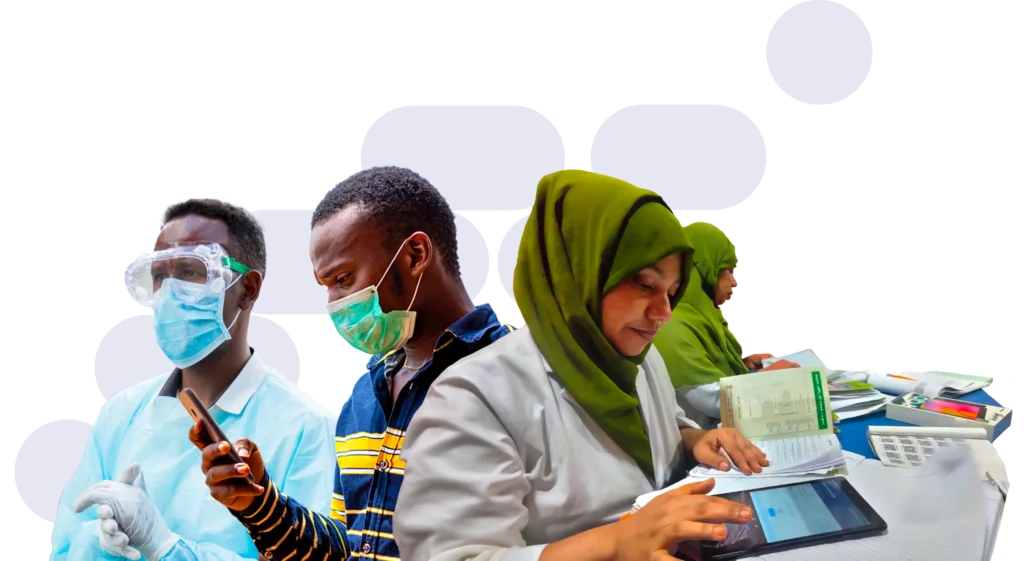
RTSL’s 2023: Year in Review is our first-ever digital annual report, looking back at a remarkable year of saving lives and making the world safer from epidemics.
Strengthening laboratory systems to meet the 7-1-7 target
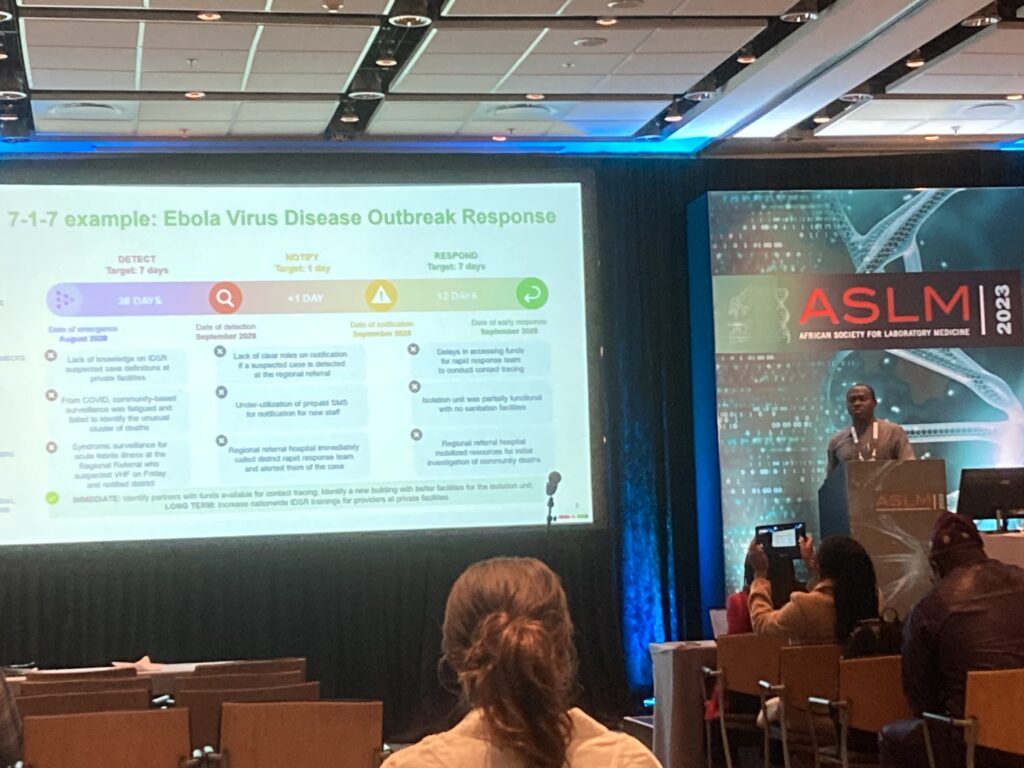
The 7-1-7 Alliance hosted a symposium at the annual conference of the African Society of Laboratory Medicine (ASLM) in Cape Town, South Africa. Panelists from the Nigeria Center for Disease Control and Prevention, ASLM, FIND and Makerere University Walter Reed Project discussed the crucial role of diagnostics in achieving the 7-1-7 target for outbreak detection […]
WHO and the 7-1-7 Alliance introduce Early Action Reviews
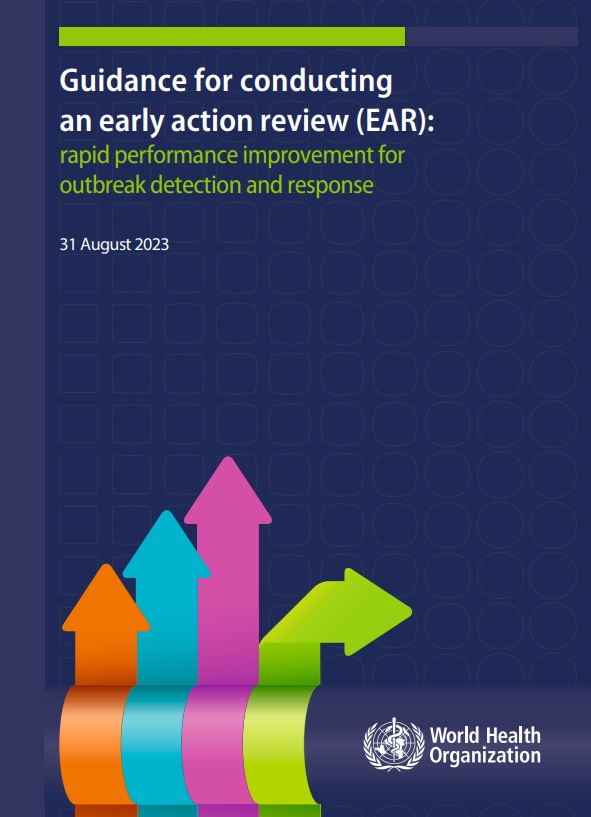
More than 500 people from 73 countries signed up to hear representatives of the World Health Organization and the 7-1-7 Alliance introduce new guidance on Early Action Reviews.
Developing technical capacity to scale up 7-1-7

The 7-1-7 Alliance hosted a training series for Atlanta-based staff of the U.S. Centers for Disease Control and Prevention. A first virtual training session introduced the 7-1-7 target, its central role in the WHO Early Action Review guidance, and how 7-1-7 fits into key components of the global health security framework. In a two-day, in-person […]
Sharing learnings to achieve the 7-1-7 target
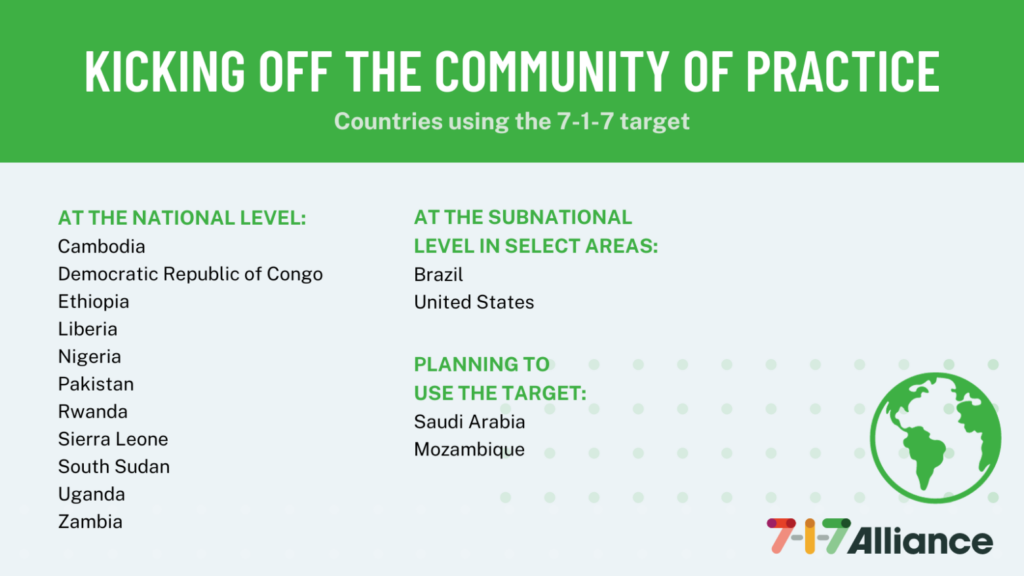
The 7-1-7 Alliance, a country-led initiative hosted by Resolve to Save Lives, formed a global community of practice with 15 implementing countries.
7-1-7 forms the bedrock of new WHO guidance

The World Health Organization’s new Guidance and tools for Conducting an Early Action Review (EAR) incorporate the 7-1-7 target for outbreak detection and control, which Resolve to Save Lives has piloted since 2021. EARs offer a performance improvement approach, which can be used for each outbreak to identify system-level bottlenecks and propose immediate and long-term […]